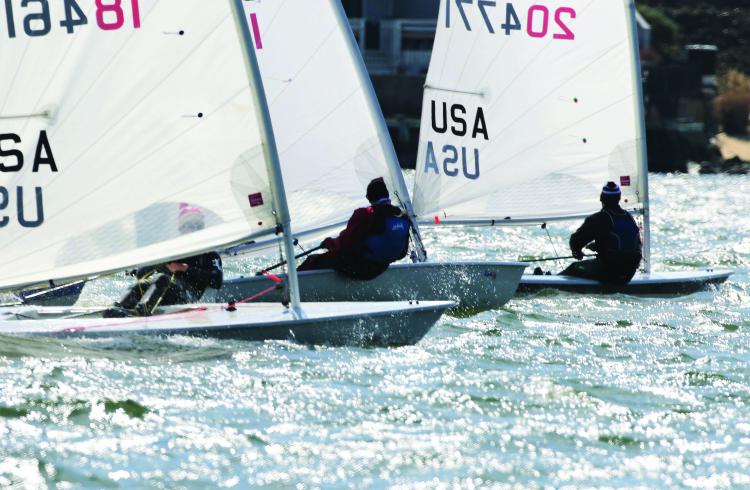A Recipe for Small Boat Racing Success: Changing Gears
It’s easy to just set it and forget it on a sailboat. Cleat the jib, set the vang, stare at the horizon a bit, and just keep going straight. That might work okay for cruising, but for racing, it’s not exactly a recipe for success.

Instead, it’s important to constantly reevaluate how your boat setup and sailing method match up with the conditions you’re experiencing. Teams that do well at “changing gears” can gain critical boat lengths over the course of a race—and that can make all the difference in rounding the weather mark in front of a pack of boats, or mired in the middle of the chaos.
Spring is a great time to focus on changing gears as you start practicing and racing. Get into good habits monitoring and responding to changing conditions now, and it will benefit you all year long.
Is something different, or is something going to be different soon?
Keeping tabs on the conditions you are sailing in, or—ideally—are about to be sailing in, is key to guiding you to proper boat setup and sailing effort. That helps you sail in the proper “gear.” There are a few ways to do this:
Looking around. Do you see puff or lulls? Potential wind shifts? Big sets of waves or chop, or flat spots? Clumps of boats that could give you bad air?
Anticipating racecourse actions. Need to anticipate building speed off the starting line? Need to slow down to optimize a leeward mark rounding?
Seeing or feeling things aren’t as good as they could be. Are you slamming into waves? Boats near you have better speed? Can’t point as high as your neighbors?
How can I get in the right gear?
If your boat setup and steering style aren’t a good match for the conditions, you’ve got to change something. Because you can’t change the conditions, it’s up to you to change what you can in your boat setup and boathandling.
The best time to identify the need for a gear change is before it happens. That way, if you’re heading in to a puff, you can depower just before you hit the puff. That means you don’t get slammed with more wind, heeling over too far and sliding sideways, before you ease the sails a bit, tighten the cunningham, drop the traveler, and so on. Big chop on the boat? Just before, rather than during, working through waves is the time to steer a touch lower and ease your sails to match to get better drive through the chop. Puff look like a header on the water or in how it’s affecting boats it’s reaching first? Try a degree or two lower and see if your entry into the new breeze goes more smoothly.
There are certainly situations where you plan ahead to get the most out of your situation. Having much of your boat setup ready for how you want it to be as you’re crossing the starting line is just one example. Doesn’t matter too much if your cunningham is a bit too tight for prestart maneuvers (within reason, of course, don’t want to blow things out!), but having it at or near the setting you want for a start in solid breeze can save an important few seconds down the road. Getting to the top mark, in traffic, easily making the mark, and don’t need to go faster? Could be a good time to pre-ease a few things to help you rocket ship away from your weather mark rounding in a faster gear than others near you.
Sounds like a lot to think about. How can I make this happen in the real world?
Communication between team members is key. If you’re singlehanding, it’s totally okay to talk this through with yourself out loud—saying things can help you remember them. Among driver and crew members, I suggest communicating a few different things:
- What you see that is going to change.
- How you are changing things to adapt/what “gear” you think you are in.
For example, a crew might say, “I see a big puff coming in five seconds. I’m pulling the vang on for you as it hits.” The driver might respond, “Thanks, I’m easing main a bit as well.”
Here’s the key second part of this evolution. Crew: “Puff has worked through, vang easing back off.” Driver: “Main back on, still a bit more wind here; only give me half the vang back on, please.”
As important as changing gears is, it’s critical to not just stay in that gear! Otherwise, you can find yourself in a downward spiral.
The “gear” analogy is not a perfect one for sailboats, as for the most part, the things we can change work on a spectrum rather than in distinct settings. Talk it all through with your team, and get ready to benefit by changing gears!
By Kim Couranz
Find more racing articles here.




